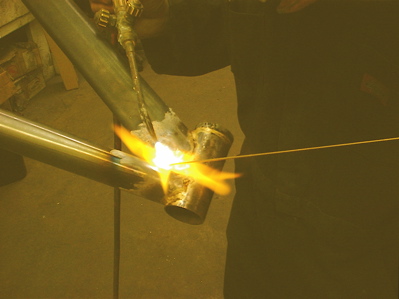The Track Bike with 3 Down Tubes

I really have a thing for steel track frames. Steel is a fantastic medium of expression for the artistry of framebuilding. And I have very specific tastes. You can search the net and find whole sites dedicated to ld skool track bikes preferably lugged steel. Even more, there is definitely a cult surrounding keirin frames from Japan. However, I grew up in the Eighties when framebuilders were making crazy machines out of fillet-brazed steel for the track sprinters of that era. I especially liked those match-sprint 3Renshos and the bikes of East Germans.
Back then steel tubing was generally round and as double-butted tubing came in a limited number of diameters. These days one can get all kinds of steel tubing with shaped cross-sections and various butting profiles. I handpicked every tube for my bike, going for maximum stiffness with little regard for weight.
You could call the tubing super-oversize, but the wall thickness is still quite beefy compared to ultra-light tubesets like Dedacciai EOM or Columbus Spirit. In fact, each of the three main triangle tubes is usually used as a down tubes on mountain bike or stout road bike. This is more complicated than it sounds, because you have to pick tubes that will have some of the butted end left over when trimmed to size, especially difficult on my ultra-compact style frame.
It took me a long time to settle on the exact tubes to use, and I actually started collecting tubes almost 2 years ago. Some of the tubes haven’t been made in a number of years; I’ve hoarded them away like rare bottles of wine. The tubes are as follows:
Dedacciai COM LTP-shaped 38mm down tube, 0.8/.5/.8mm wall
Dedacciai SAT 35mm down tube, 0.8/.5mm wall (cut down for use as seat tube)
Columbus MAX 34.9mm down tube, bi-ovalized .8/.5/.8mm wall (use as top tube)
Columbus MAX chainstays, 36/18mm, .9/.6 wall
Columbus ZONA 19mm single-taper, s-bend seat stays, .6mm wall
Columbus CYBER 36.1mm head tube, 1.1mm wall
The stiffness of round steel tubes is simple to understand. The only things that matter are diameter and wall thickness, and both of these are on my side.
A track frame won’t have many extraneous pieces, but what bits there are I have carefully chosen. I’ve always like the look of the Surly track tip (originally marketed as Sub 11.0, a reference to a bench mark time for a match sprint qualification). I think they look especially clean on a fillet-brazed bike, and they offer a mechanically sound connection for the stays. The bottom bracket shell is machined and internally-relieved by Silva of Italy. Also from Silva is a braze-on head tube reinforcement ring and chainstay bridge. Finally, I machined a seat tube cap out of regular aircraft steel to bring the seat tube ID down to fit a 31.6mm seat post.
All that steel still needs to be mitered and joined together. That’s where Sycip Design comes in. As I said before, this frame is the latest in a series of track frames Jeremy has built for me over the years. I have progressively become more involved in each design. I think that there is definitely a point beyond which the customer may be impinging on the builder’s territory, but Jeremy has been pretty easy going about. I was pretty clear about what I wanted but stayed open to Jeremy’s suggestions for better solutions.
One thing I’ve liked about Jeremy’s work is the precision with which he builds. A lot of people think that all the skill in bike is invested in fancy lugs, clever details, and complicated paintjobs. It’s much harder to see how straight a frame is, how the angles exactly match the design spec, how all the points line up. The simplicity of a track frame sets these in sharper relief than a road frame, and you are more likely to feel it from the saddle on a track bike too. I said that I designed the bike down to the millimeter, and Jeremy has always hit my design spec. About the only aesthetic construction detail I asked about was the fillet-brazing. I think the best fillet-braze is the one you almost can’t see, one so smooth in the transition that the eye cannot discern where the brass ends. Sycip is pretty good at that too.